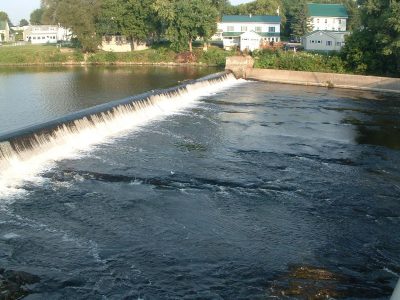July 18th, 2016–Today, the Vermont Natural Resources Council (VNRC), The Nature Conservancy (TNC), Lake Champlain International (LCI) and Trout Unlimited (TU), formally lodged their objection to the licensing of the Swanton Dam as a hydroelectric facility, citing the dam’s significant impact on fisheries and water quality.
The Swanton Dam was developed in the 18th century to power mills and other industries. Since the 1960s, the dam has served no practical purpose. The dam is owned by the Village of Swanton, which has partnered with Swanton Hydro, LLC to develop and operate the dam as a hydroelectric facility. Recently, Swanton Hydro, LLC filed an application for a preliminary permit from the Federal Energy Regulatory Commission (FERC). If granted, the preliminary permit would give Swanton Hydro the exclusive right to pursue developing a hydroelectric facility at the dam.
The Swanton Dam has a profound impact on fisheries and water quality. Located on the Missisquoi River, 6 miles upstream from Lake Champlain, the dam has significantly impaired a historic salmon run, and habitat for walleye and sturgeon, a state-listed endangered species. Environmentalists have been advocating for years that the Swanton Dam should be removed.
Jon Groveman, Policy and Water Program Director with VNRC said, “in filing this application, Swanton Hydro and the Village of Swanton are headed in the wrong direction. VNRC supports hydroelectric power as part of a diverse mix of renewable energy sources in Vermont. However, the significant ecological impacts of the Swanton Dam, some which are impossible to mitigate, make it the wrong dam to use to generate power.”
Shayne Jaquith, The Nature Conservancy’s Watershed Restoration Manager, offered, “TNC has a strong history of working with hydro operators to manage their dams in a way that benefits both the waterway and energy production. In this case, the impacts to threatened and endangered fish and mussel species and the health of the Lower Missisquoi River and Lake Champlain, far outweigh the benefits that would be derived from the limited energy output of the proposed hydro facility.”
Lake Champlain International’s Executive Director, James Ehlers, stated “This is not the Trustees’ first attempt at a permit. Their previous one failed. This is a horrible location for a dam, economically and ecologically. Take it down now, and stop wasting taxpayer money and destroying fisheries. Return the river to the people of Vermont to whom it rightfully belongs, and let’s come together for a serious discussion on what a sustainable Swanton actually looks like
Jared Carpenter of Vermont Council of Trout Unlimited, “We understand that responsible hydropower that minimizes environmental impacts is part of a diverse renewable energy portfolio. But it appears that opportunity has been long lost in this deteriorating dam. It provides no benefit and simply harms the environment and threatens public safety. Whenever possible, dams like this should be removed to reconnect our rivers and restore habitat.”
The four groups are requesting to be allowed to intervene in the FERC proceeding to address their concerns about the environmental impacts of the dam. To learn more about the negative impacts of derelict dams on our waterways and the benefits of removal, please visit the partner website www.freevtrivers.org
Media Contacts:
Vermont Natural Resources Council: Jon Groveman, phone 802 223 2328 x111, jgroveman@vnrc.org
The Nature Conservancy: Shayne Jaquith, 802 229 4425 x 105, Shayne.jaquith@tnc.org
Lake Champlain International: James Ehlers, 802 879 2016, james@champlain.ngo
Vermont Council of Trout Unlimited: Jared Carpenter, 802 356-3666, rjaredcarpenter@gmail.com




